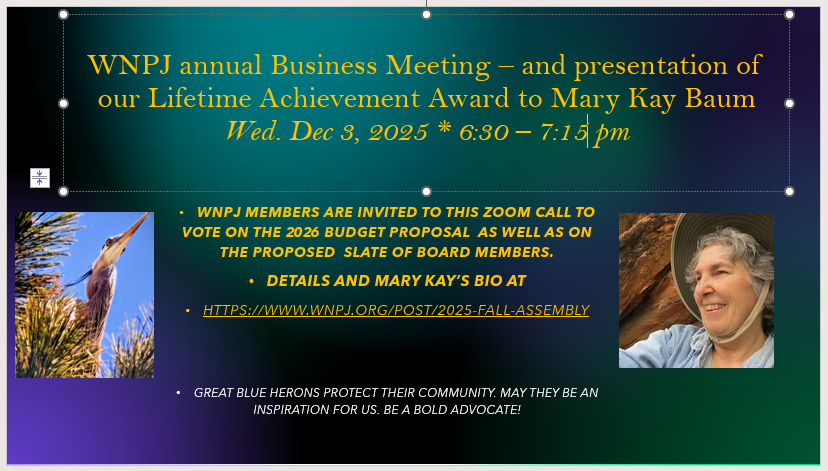Can Nuclear Power Be the Answer?
- judeminer0
- Oct 19, 2022
- 5 min read
This article from the Nukewatch Quarterly Summer newsletter, 2022, written by Alfred Meyer .... former chair of the WNPJ Board.

What are the consequences of using nuclear power to address climate change? Is nuclear power clean energy? Can it deliver reduction in greenhouse gases soon enough to help minimize climate chaos, with ‘soon enough’ defined as 10 years or less by the 2022 International Panel on Climate Change? Lastly, what part does the nuclear power industry play in enabling our nuclear navy and nuclear weapons?
The consequences of operating nuclear reactors include: • Carbon dioxide (CO2), radioactive [1] and toxic emissions at each step in the nuclear fuel chain, the vast industrial infrastructure, parts of which are in almost every state in the U.S.; • Regular, planned releases of radioactivity into the air and water; • Thermal pollution of the surface water which provides the vast amounts of water needed to cool waste fuel and fissioning uranium fuel rods in the core; • Accidents, leaks and unplanned, unregulated releases of radioactive gases, liquids and solids into the biosphere; • Many forms of radioactive wastes, some of which remain toxic for millions of years, all while we don’t know how to safely store them for the next 100 years, much less for millions of years; and • Providing the academic, industrial and governmental infrastructures which are, according to former Energy Secretary Ernest J. Moniz, fundamental enablers of our nuclear navy and nuclear weapons [2], contributing some $42.4 billion per year for these purposes.[3]
This is a formidable list of significant consequences. Given these impacts, nuclear power is clearly not a clean source of electricity, even though fissioning uranium, in and of itself, does not emit large amounts of CO2. The CO2 which nuclear power does put into the environment is hazardously radioactive. Nuclear reactors produce many other toxic and deadly emissions, as well as nuclear waste. We don’t know the full effects of ionizing radiation on living things and our planetary ecology, but what we do know is that in humans it can cause cancer and diseases of the pulmonary, cardiac and immune systems. In one sense, the worldwide nuclear enterprise has put all of us into a non-consensual, unplanned, unmanaged and out-of-control human experiment which involves irradiating our biosphere.
Due in part to research about the radioactive strontium-90 from atmospheric nuclear weapons tests found in kids’ teeth around 1960, President John F. Kennedy signed the Partial Test Ban Treaty in 1963 in an effort to reduce our exposure to radioactivity. According to the National Academy of Sciences, all exposure to ionizing radiation increases health risks, which are cumulative over our lifetimes.[4]
While one could argue based on these consequences alone that nuclear power should be stopped rather than promoted, let us consider if nuclear power can really be a part of the solution to climate change. Climate change, like nuclear weapons, poses existential threats to life on earth, so if nuclear power can play an essential part in mitigating climate change, then maybe accepting the above known and unknown detriments of nuclear power is just part of the price of survival. A steep price for sure, in environmental, health, financing, and nuclear weapons dangers, but no price is too high if it is the only path to survival, right? Do we have to accept nuclear power’s clearly evident risks to avert climate chaos?
To avert climate chaos we have 10 years or less to significantly reduce CO2. While some of the 93 operating reactors in the U.S. are eligible for $6 billion of taxpayer subsidies to help them survive economically, the aging facilities are becoming increasingly dangerous and expensive to operate. Most of the cheerleading for new nuclear power, encouraged by $2.5 billion of new government funding, focuses on small modular reactors (SMRs), sodium-cooled reactors, generation IV reactors, and even micro reactors.
In theory, this is an impressive lineup of technology’s cutting edge. In fact, it is largely new packages for old ideas, existing on paper only. It will take decades of research & development, prototype testing, creation of industrial capacity, and the unit-by-unit construction before new nuclear reactors can be operational. But, we don’t have that much time; we need truly clean energy that we can install now at a reasonable price with minimal harmful environmental effects to be on-line in less than 10 years! New nuclear can’t meet the time line. If nuclear is as bad as all that, why do we have it?
If nuclear power is so fundamentally dirty, dangerous and expensive — with a growing waste problem that we haven’t yet solved — and new nuclear cannot deliver in time, if at all, why is nuclear power such a prevalent hope for so many, including some anti-nuclear weapons activists who think we need it to address climate change? Remembering that the public is saddled with the risks of these endeavors — environmental, medical, and financial — while private corporations take the profit, why does anyone believe that nuclear power is worth so many of our dollars?
The short answer is “Atoms for Peace,” the U.S. government’s program announced at the UN by President Eisenhower in 1953. He introduced the peaceful uranium-235 atom, as an antidote to that war-making U-235 that incinerated Hiroshima and horrified the world.
Atoms for Peace put a smiley face on the nuclear enterprise, drawing attention away from military weapons and their massive destruction, and instead directing attention to the promises of unlimited benefits. This program proliferated nuclear technology to over 40 nations around the world, including Iran, and was based on the aspirational atom that we would “tame” to “serve” us, with electricity “too cheap to meter” — along with atomic cars, boats, ships and rockets — truly a phantasmagorical and mythical cultural promise, which does not exist in reality.
Certainly nuclear weapons are the most potent instruments of destruction in the world. As illustrated by the Manhattan Project begun in 1942, nuclear weapons depend upon an extensive scientific/industrial/academic/ infrastructure. Ernest Moniz, mentioned above, has clearly illustrated how much our nuclear military depends on the civilian nuclear power infrastructure, calling it “an essential enabler of national security.” The Atlantic Council in Washington, DC also mentioned above, calculates the value of this contribution to be $42.4 billion per year. In other words, if you support nuclear power, you are enabling nuclear weapons.
Is nuclear power really the answer?
— Alfred Meyer is a member of Physicians for Social Responsibility and has worked with communities affected by both the Chernobyl and Fukushima catastrophes.
- Alfred welcomes comments and questions: send to alfred.c.meyer@gmail.com
***************************************** Endnotes: [1] Radioactivity is ionizing energy that is damaging to human health and other living things; see page 4, “New Study: Cancer Epidemic.” [2] The reference is to MIT physicist, ex-Secretary of Energy, and Co-Chair and CEO of Nuclear Threat Initiative (nti.org), Ernest J. Moniz. See: Energy Futures Initiative, “The U.S. Nuclear Energy Enterprise: A Key National Security Enabler,” August 2017. [3] “What is the value of the U.S. nuclear power complex to U.S. national security,” an Issue Brief by The Atlantic Council, a prominent Washington, DC think tank, Oct. 21, 2019. [4] National Academy of Sciences, “Health Risks from Exposure to Low Levels of Ionizing Radiation BEIR VII, Phase 2” (2006).




Comments